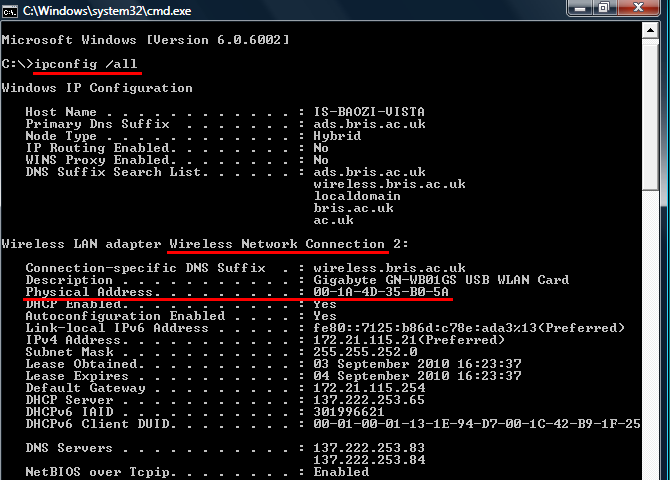When Terminal has launched, type the following command: ipconfig getifaddr en0 (to find your IP address if you are connected to a wireless network) or ipconfig getifaddr en1 (if you are connected to an Ethernet). If you are using Mac OS X, the command ipconfig grep inet displays detailed information about your computer signification in the. IPCONFIG /showclassid adapter Display all the DHCP class IDs allowed for adapter. IPCONFIG /setclassid adapter classid Modify the dhcp class id. If the Adapter name contains spaces, use quotes: 'Adapter Name' Wildcard characters. and? Are allowed, see the examples below The default is to display only the IP address, subnet mask and default. Thank you for choosing Amcrest as your home security solution! Click the appropriate link below to download the IP Config software: Amcrest IP Config Tool for Windows Amcrest IP Config Tool for Mac.
Configure IP (Internet Protocol configuration)
If the Adapter name contains spaces, use quotes: 'Adapter Name'
Wildcard characters * and ? are allowed, see the examples below
The default is to display only the IP address, subnet mask and default gateway for each adapter bound to TCP/IP.
For Release and Renew, if no adapter name is specified, then the IP address leases for all adapters bound to TCP/IP will be released or renewed.
If you remote into a computer and run ipconfig /release it will kill your connection
For setclassid, if no CLASS ID is specified, then the CLASS ID is removed.
DHCP User Classes allow additional or modified DHCP options to be applied to a subset of computers on the network, as identified by a CLASS ID. For example, a different gateway, DNS server, or lease time.
This requires configuring the CLASS ID appropriately on the DHCP server. see RFC 3004
Examples:
Show detailed information
C:> ipconfig /all
Release and Renew all adapters:
ipconfig /release
ipconfig /renew
Release and Renew all adapters - one liner for remote use:
ipconfig /release && ipconfig /renew
Renew any connection that has a name starting with EL:
ipconfig /renew EL*
Release all connections matching *Con*, eg. 'Local Area Connection 1' or 'Local Area Connection 2':
ipconfig /release *Con*
Set the DHCP class ID for the named adapter to TEST:
ipconfig /setclassid 'Local Area Connection' TEST
“Life is a grand adventure - or it is nothing” ~ Helen Keller
Related:
BROWSTAT - Get domain, browser and PDC info.
NETSTAT - Display networking statistics (TCP/IP).
NETSH - Configure interfaces, routing protocols, filters, routes, RRAS.
PATHPING - IP trace utility.
PING - Test a network connection.
Configure the hosts file to redirect or block urls.
Q813878 - How to block specific network protocols and ports.
Q313190 - Use IPSec IP Filter Lists.
Domain Name System - docs.microsoft.com
ipchicken - Display your current IP.
Equivalent bash command (Linux): dhcpcd, lookupd -flushcache, ifconfig - IP configuration.
Equivalent PowerShell command: Clear-DnsClientCache - Clear the content of the DNS client cache.
Equivalent bash command (OS X): ipconfig / dscacheutil - View IP config / Query / flush the Directory Service cache. Driver samsung scx 4200 for mac.
Some rights reserved
Mac OS X ipconfig
 © May 2019 Anthony Lawrence
© May 2019 Anthony LawrenceJuly 2006

If you momentarily forget where you are at a Mac OS X terminal session, you might type 'ipconfig /all' or something equally Windowish. You will get a response:
usage: ipconfig <command> <args>>
where <command> is one of waitall, getifaddr, ifcount, getoption, getpacket, set, setverbose

What's this? You already know you mistyped: on Mac OS X you probably meant to run 'ifconfig -a' just as you would on Linux. But 'ipconfig' is different, and is actually something good to have in your bag of tricks.
The first thing ipconfig can do for you is quickly give you all your dhcp info:
$ ipconfig getpacket en0
op = BOOTREPLY
htype = 1
flags = 0
hlen = 6
hops = 0
xid = 1045997387
secs = 0
ciaddr = 0.0.0.0
yiaddr = 192.168.9.30
siaddr = 0.0.0.0
giaddr = 0.0.0.0
chaddr = 0:16:cb:8d:38:f7
sname =
file =
options:
Options count is 7
dhcp_message_type (uint8): ACK 0x5
subnet_mask (ip): 255.255.255.0
lease_time (uint32): 0x93a80
router (ip_mult): {192.168.9.254}
domain_name_server (ip_mult): {192.168.9.254}
server_identifier (ip): 192.168.9.254
end (none):
There are shortcuts to the items listed under 'options':
$ ipconfig getoption en0 router
192.168.9.254
$ ipconfig getoption en0 domain_name_server
192.168.9.254
'ipconfig getifaddr en0' is a quick way to just get the ip address.You can also use ipconfig with its 'set' options to change an interface from DHCP to manual or vice-versa. That's temporary; it doesn't write any start up files.
If you are having difficulty with DHCP, ipconfig has one more use: you can (as root) set verbose logging with 'ipconfig setverbose 1'. With that set, you get minor debugging info written to syslog (/var/log/system.log on my system), but you also get a separate BOOTP/DHCP log in /var/log/com.apple.IPConfiguration.bootp that shows the full BOOTREQUEST/BOOTREPLY packet negotiation.
Think of ipconfig the next time you are looking for DHCP info on a Mac.
Got something to add? Send me email.
(OLDER) <- More Stuff -> (NEWER) (NEWEST)
Printer Friendly Version
-> -> Mac OS X ipconfig


Ipconfig For Mac Address
Inexpensive and informative Apple related e-books:
Digital Sharing Crash Course
Are Your Bits Flipped?
Take Control of Automating Your Mac
Take Control of High Sierra
Take Control of Apple Mail, Third Edition
